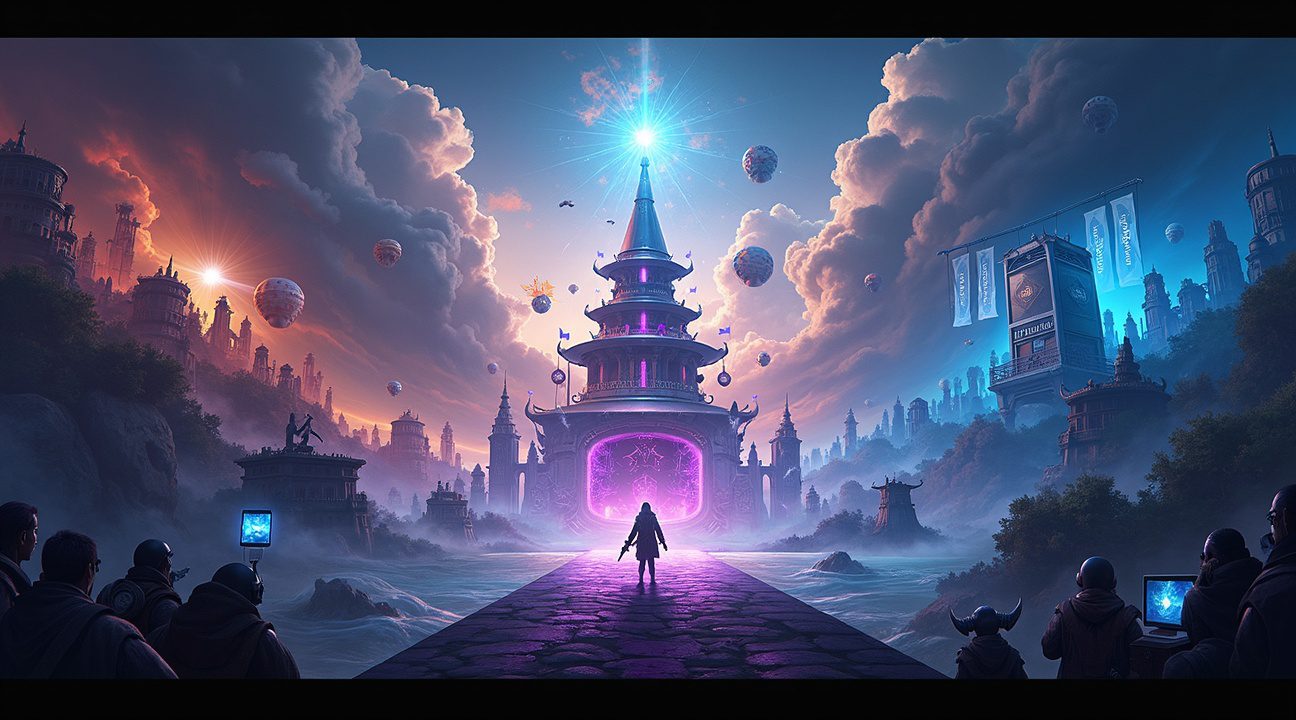Riot Games evolved from a single-game company centered on League of Legends into a comprehensive entertainment powerhouse through strategic expansion across multiple gaming genres and platforms.
Key Takeaways
- Riot successfully diversified from League of Legends into multiple genres including the competitive shooter Valorant, mobile gaming with Wild Rift, and card games with Legends of Runeterra
- The company maintains 117-145 million monthly active players in League of Legends as of 2025, proving their original game remains central to their strategy despite expansion efforts
- Valorant’s 2020 launch marked Riot’s boldest departure from their established universe, creating an independent franchise that competes effectively outside the MOBA genre
- Strategic platform expansion includes mobile gaming penetration, competitive shooter dominance, single-player experiences, and auto-battler innovation through Teamfight Tactics
- Riot revolutionized gaming economics by pioneering the free-to-play model with cosmetic microtransactions and establishing modern esports franchising systems that influenced the entire competitive gaming industry
Valorant and the Multi-Game Revolution That Changed Riot Forever
Riot Games fundamentally transformed its identity from a single-game developer into a comprehensive entertainment powerhouse through strategic expansion into multiple gaming genres. I’ve watched this evolution unfold as the company leveraged its success with League of Legends to build an impressive portfolio that spans across different platforms and gameplay styles.
The company’s diversification strategy began with titles that remained connected to the League of Legends universe. Teamfight Tactics emerged as an auto-battler spin-off that captured the growing popularity of this genre while utilizing familiar champions and mechanics. Legends of Runeterra followed as a digital collectible card game, allowing players to explore the rich lore and characters from Runeterra in a completely different format. These initial expansions demonstrated Riot’s ability to reimagine its core intellectual property across various gaming experiences.
However, the most significant breakthrough came with Valorant’s launch in 2020. This first-person shooter marked a bold departure from Riot’s established universe, creating an entirely new world with unique characters and mechanics. Unlike previous releases that drew heavily from League of Legends’ foundation, Valorant stood as an independent franchise that quickly established itself among the world’s most popular competitive shooters. The game’s success proved that Riot could compete effectively outside the MOBA genre and attract entirely new audiences.
Strategic Expansion Across Platforms and Genres
Riot’s expansion strategy encompasses several key areas that demonstrate the company’s comprehensive approach to growth:
- Mobile gaming penetration through League of Legends: Wild Rift, bringing the core MOBA experience to smartphones and tablets
- Competitive shooter dominance with Valorant franchising establishing professional leagues worldwide
- Single-player experiences like Ruined King: A League of Legends Story, offering narrative-driven adventures
- Auto-battler innovation through Teamfight Tactics, capitalizing on emerging gaming trends
- Digital card game excellence with Legends of Runeterra, competing directly with established titles like Hearthstone
Wild Rift represents Riot’s calculated entry into the mobile gaming market, adapting the complex mechanics of League of Legends for touch controls and shorter match durations. This adaptation required significant technical innovation and design modifications while preserving the core gameplay that made the original so compelling. The mobile version opened up entirely new markets, particularly in regions where mobile gaming dominates the landscape.
Valorant’s impact extends far beyond just game development. The title revolutionized Riot’s approach to competitive gaming and entertainment partnerships, establishing franchised leagues that mirror traditional sports structures. This strategic approach created sustainable revenue streams while building long-term competitive ecosystems that benefit players, organizations, and fans alike.
The smaller spin-off games like Ruined King demonstrate Riot’s commitment to exploring different storytelling methods and gameplay mechanics. These titles allow the company to experiment with new concepts while providing fresh perspectives on beloved characters and locations. Each release builds upon the extensive lore that has developed over more than a decade of League of Legends content.
Despite this aggressive expansion into new territories, Riot maintains its core commitment to the League of Legends universe. The company continues investing heavily in champion development, game updates, and competitive infrastructure. Major partnerships, such as the collaboration with luxury brands, demonstrate how the original game remains central to Riot’s overall strategy.
This multi-franchise approach has fundamentally changed how I view Riot Games as a company. Rather than being known solely for one incredibly successful title, they’ve positioned themselves as a comprehensive gaming publisher capable of competing across multiple genres and platforms. The transformation from a single-game studio to a diverse entertainment company represents one of the most successful pivots in modern gaming history.

League of Legends Still Dominates Gaming in 2025 With Staggering Player Numbers
League of Legends achieved global popularity almost immediately after its launch and continues to hold its position as one of the most played games worldwide. I’ve watched this phenomenon unfold over more than a decade, and the numbers remain absolutely staggering. As of 2025, the game boasts between 117 to 145 million monthly active players, with daily active user numbers consistently ranging from 30 to 40 million players logging in every single day.
Massive Player Base Continues Growing
The scale becomes even more impressive when examining the total registered accounts, which have surpassed 180 million users. This represents an enormous community that has grown steadily since the game’s early days. February 2022 marked a significant milestone when the peak daily user count reached 14 million, while live concurrent players consistently surpass one million at any given moment.
Player Distribution and Engagement Strategies
Most players fall between the Silver and Platinum ranks, accounting for over 80 million users globally. This distribution shows how accessible yet challenging the game remains for the average player. Riot has maintained this incredible engagement through strategic content additions, introducing new game modes that keep the experience fresh and exciting.
The company’s approach to player retention includes popular alternatives like ARAM (All Random All Mid) and Teamfight Tactics (TFT). These modes provide different ways to enjoy the core League experience without requiring the full commitment of a traditional ranked match. TFT, in particular, has become a phenomenon in its own right, attracting players who prefer auto-battler gameplay over the traditional MOBA format.
Riot’s success with League extends beyond just player numbers. The game has spawned an entire entertainment ecosystem, including an award-winning animated series that have brought new audiences into the League universe. This multi-media approach has helped sustain interest and attract players who might never have discovered the game otherwise.
The competitive scene remains equally impressive, with professional leagues operating globally and drawing millions of viewers. Events like the World Championship continue to break viewership records, sometimes featuring partnerships with luxury brands that elevate the entire esports industry’s profile.
What makes these numbers particularly remarkable is how League has maintained its dominance despite fierce competition from newer titles. While other games have captured temporary attention, League’s consistent updates, seasonal changes, and community engagement have kept players returning year after year. The game’s ability to evolve while maintaining its core identity demonstrates why it continues to set the standard for online multiplayer gaming in 2025.

From USC Roommates to Gaming Giants: The Founding Story
Two college roommates at the University of Southern California had no idea their shared passion for gaming would eventually create one of the world’s most influential gaming companies. Brandon Beck and Marc Merrill founded Riot Games in September 2006, driven by a simple yet ambitious vision: develop a long-term, player-focused game that could capture the magic they experienced playing Defense of the Ancients (DotA).
The duo’s inspiration came directly from their countless hours spent playing DotA, a popular mod for Warcraft III that had captured the attention of competitive gamers worldwide. Beck and Merrill recognized the untapped potential in this genre and believed they could create something even more compelling. Their focus wasn’t just on building another game – they wanted to establish a company that would prioritize player experience above all else.
Building the Foundation with Strategic Funding
Turning their vision into reality required significant capital, and the founders proved adept at securing the necessary resources. They initially raised $1.5 million from family members and angel investors who believed in their concept. This early funding allowed them to begin developing their ideas and attract additional talent to their growing team.
The company’s financial foundation solidified further when they secured an additional $8 million from venture capital firms and Tencent, the Chinese technology conglomerate. This substantial investment validated their business model and provided the resources needed to compete in the increasingly competitive gaming market. Tencent’s involvement would prove particularly significant, as the company would later become Riot’s majority owner.
Riot established its headquarters in Santa Monica, California, choosing an unconventional workspace that reflected their innovative approach. Their first office operated out of a converted machine shop, creating a unique environment that fostered creativity and collaboration. This humble beginning would eventually grow into multiple offices worldwide as the company expanded its reach.
The culmination of their efforts came to fruition when League of Legends officially launched in North America and Europe on October 27, 2009. This launch date marked a pivotal moment not just for Riot Games, but for the entire gaming industry. The game introduced revolutionary features like a free-to-play model supported by cosmetic purchases, setting a new standard for monetization in competitive gaming.
The company’s early success exceeded expectations, generating approximately $1.29 million in revenue by the end of 2009. This impressive figure demonstrated that their player-focused approach resonated with audiences and validated their decision to prioritize long-term engagement over short-term profits. The revenue milestone proved that free-to-play games could indeed generate substantial income when executed properly.
Beck and Merrill’s journey from USC dormmates to industry leaders illustrates how passion, vision, and strategic execution can transform simple ideas into global phenomena. Their emphasis on player satisfaction and community building laid the groundwork for what would become one of esports’ most celebrated titles.
The founding story of Riot Games demonstrates that successful gaming companies aren’t built overnight. Instead, they require careful planning, adequate funding, and most importantly, a deep understanding of what players truly want. Beck and Merrill’s commitment to creating lasting value for their community established the foundation for Riot’s future expansion into multiple gaming genres and entertainment ventures.
Their initial success with League of Legends would eventually pave the way for additional competitive gaming titles and even ventures into animated entertainment, proving that their original vision extended far beyond a single game.
How Riot Revolutionized Gaming Economics and Built an eSports Empire
Riot Games fundamentally transformed the gaming industry by pioneering a free-to-play model that relied on microtransactions for cosmetic items and in-game perks rather than upfront purchase costs. This approach democratized access to League of Legends while creating sustainable revenue streams through player choice rather than forced purchases. I’ve observed how this model shifted industry standards, with countless developers adopting similar strategies across various game genres.
Strategic Business Moves That Changed Everything
The company’s decision to take control of European distribution in 2010 marked a pivotal moment in their expansion strategy. Moving headquarters from Brighton to Dublin resulted in a remarkable 9% increase in European user growth within just three months, demonstrating how strategic positioning can directly impact player acquisition. This move also allowed Riot to better understand regional preferences and tailor their approach to different markets.
Recent monetization changes have sparked significant debate within the community. Riot removed free Hextech chests and implemented new skin reward systems, creating controversy among long-time players while simultaneously boosting revenue. These decisions reflect the delicate balance between profitability and player satisfaction that defines modern gaming economics.
Building the Modern eSports Foundation
Riot elevated League of Legends tournaments to professional sports event status, essentially creating the blueprint for modern eSports franchising systems. I’ve witnessed how their tournament structure influenced everything from player contracts to broadcast production values across the entire competitive gaming landscape. The company established viewing experiences that rival traditional sports, complete with professional commentary, high-production broadcasts, and substantial prize pools.
Their approach to community engagement extends beyond competitive play through frequent updates informed by player feedback. Rotating events, seasonal content, and cross-media partnerships maintain high engagement levels even as market saturation increases. Arcane’s success exemplifies how Riot leverages their intellectual property across multiple entertainment mediums, creating additional revenue streams while strengthening brand loyalty.
The company’s evolution from a single-game studio to a multimedia entertainment powerhouse demonstrates how understanding player psychology and market dynamics can sustain growth over more than a decade. Their willingness to adapt monetization strategies, even when controversial, shows commitment to long-term viability over short-term popularity. This strategic flexibility has enabled Riot to maintain League of Legends’ position as a dominant force while expanding into new gaming territories and entertainment formats.
Sources:
Zippia – Riot Games History: Founding, Timeline, and Milestones
Icon Era – League Of Legends Live Player Count And Statistics
Wikipedia – Riot Games
Lagofast – League of Legends Player Count & Stats 2025
Riot Games (PDF) – Riot Games Fact Sheet
Turbosmurfs.gg – League of Legends: Player Count and Statistics 2025
Simple English Wikipedia – Riot Games
Udonis – League of Legends Player Count, Revenue, & Stats [2025]


